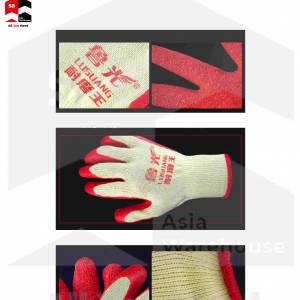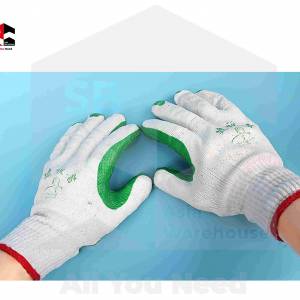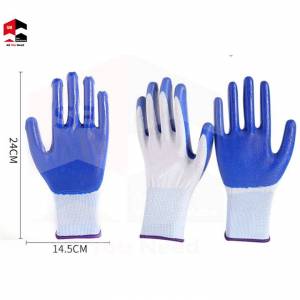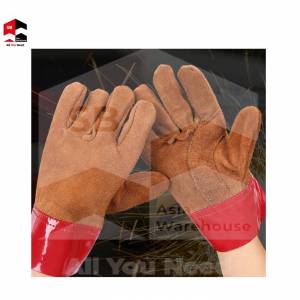Showing all 8 results
Best Safety Glove Supplier in Malaysia
As premier Malaysia’s safety glove supplier, Asia Warehouse prides itself on delivering top-quality products that prioritise the safety and well-being of our clients. Our extensive range of gloves is meticulously designed to meet the highest industry standards, ensuring maximum protection in various work environments. With a commitment to excellence and customer satisfaction, we only stock high-quality safety gloves that provide peace of mind and unmatched performance. Partner with us for unparalleled quality and service in safety gloves.
Frequently Asked Questions Regarding Safety Gloves
What is safety gloves?
Within personal protective equipment (PPE), safety gloves play a critical role in safeguarding hands from occupational and environmental hazards. Crafted from specialised materials like Kevlar, nitrile, rubber and leather, these essential barriers offer targeted protection against various risks, including cuts, punctures, abrasions, chemicals, heat, and cold. Selecting the optimal glove demands a meticulous approach, considering the hazards encountered, the wearer’s comfort and skill requirements, and the necessary grip level.
What are the different types of safety gloves?
Many safety gloves are available, each designed to protect against specific hazards. Some of the most common types include:
- Cut-resistant gloves: These gloves with various cut level are made from materials resistant to cuts, such as Kevlar or stainless steel. They ensure cut resistance to protect workers from sharp edges, blades, and broken glass.
- Puncture-resistant gloves: These gloves are made from materials resistant to punctures, such as Kevlar or nitrile. They are used to protect workers from hazards such as nails, screws, and needles.
- Abrasion-resistant gloves: These gloves are made from abrasion-resistant materials, such as leather or cowhide. They protect workers from rough surfaces, friction, and heat.
- Chemical-resistant gloves: These gloves are made from materials resistant to chemicals, such as nitrile or neoprene. They protect workers from hazards such as acids, solvents, and other harmful substances.
- Heat-resistant gloves: These are made from heat-resistant materials, such as aluminised fabric or Nomex. They protect workers from hazards such as open flames, hot surfaces, and molten metal.
- Cold-resistant gloves: These gloves are made from insulated materials to warm hands in cold environments. They protect workers from hazards such as cold water, ice, and freezing temperatures.
- Electrical-resistant gloves: These gloves are made from insulated materials to protect workers from electrical shock. They are used to work on live electrical equipment.
What are the uses of hand gloves?
While safety is often the primary focus, hand gloves have diverse uses beyond hand protection:
- Warmth: Insulated gloves combat chilly weather, keeping hands comfortable for working in cold environments.
- Grip and dexterity: Gloves enhance handling in various situations, from gripping tools for construction to manoeuvring objects in production.
- Hygiene and contamination control: Disposable gloves prevent cross-contamination and other hygiene-sensitive areas like cleaning and disinfection.
What are the 3 rules around gloves?
The three most crucial “rules” around gloves depend on the context of their use, whether for safety, hygiene, or other purposes. However, three general rules apply in many situations:
- Choose the right glove for the right job: This is paramount for safety and effectiveness. Consider the hazards or tasks and select gloves with appropriate materials and features. Don’t wear gardening gloves for handling chemicals, for example.
- Maintain proper fit and care: Ill-fitting gloves can be ineffective or dangerous. Please choose the correct size and ensure they fit snugly but comfortably. Follow manufacturer instructions for cleaning and storage to prolong their lifespan and effectiveness.
- Prioritise hygiene and safety: Wash or sanitise hands before and after wearing gloves, especially in hygiene-sensitive situations. Remove and dispose of contaminated gloves promptly. Never reuse disposable gloves or wear damaged ones.
How often should I replace safety gloves?
Routine replacement intervals, such as every six months or annually, may be established based on the specific workplace conditions and the manufacturer’s recommendations. The frequency of replacing safety gloves depends on various factors, including the type of gloves, the nature of the work, the level of wear and tear and their brands. In general, it is advisable to inspect gloves regularly for signs of damage, such as cuts, tears, or chemical degradation. If any damage is detected, gloves should be replaced immediately to ensure adequate protection. Additionally, gloves should be replaced if they no longer provide a snug fit or become contaminated with hazardous substances.








